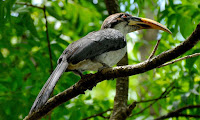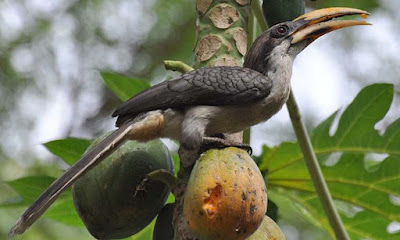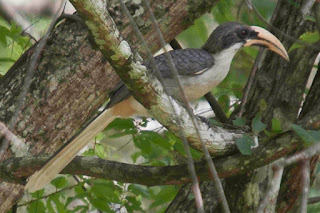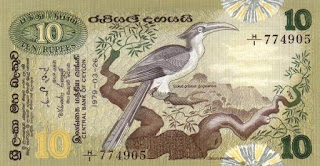Ceylon Grey Hornbill Ocyceros gingalensis
(Sri Lanka Grey Hornbill)
(Endemic bird in Sri Lanka)
Sinhalese - Kedetta
Tamil - Irattai - kondu- kuruvi
 The Grey Hornbill is a bird of forest and well wooded areas. It is found
both in the wet and dry zones and ascends the hills up to about 1300 metres. In
the Dry zone it favours riverine forests though in the Wilpattu National Park
it inhabits forest close to the villus as well. It is a grotesque looking bird
with an enormous decurved beak, long neck and long tail. Both sexes have
similar plumage but the beak of the female is dark with a long cream patch on
the upper mandible in contrast to the mostly pale yellow beak of the male.
Young are similar to adults but have shorter beaks which are pale yellow,
completely devoid of any black colour. Their irides too are grey in contrast to
the red irides of adults. The Grey Hornbill generally occupies mid levels of forest
and moves about in pairs, though flocks too are met with near fruiting trees.
The food consists mostly of fruit but animal matter is also captured especially
when young have to be fed. The call is a loud kaa, kaa, kaa. At
times a continuous kak,kak,kak, kak,kak call is
uttered.
The Grey Hornbill is a bird of forest and well wooded areas. It is found
both in the wet and dry zones and ascends the hills up to about 1300 metres. In
the Dry zone it favours riverine forests though in the Wilpattu National Park
it inhabits forest close to the villus as well. It is a grotesque looking bird
with an enormous decurved beak, long neck and long tail. Both sexes have
similar plumage but the beak of the female is dark with a long cream patch on
the upper mandible in contrast to the mostly pale yellow beak of the male.
Young are similar to adults but have shorter beaks which are pale yellow,
completely devoid of any black colour. Their irides too are grey in contrast to
the red irides of adults. The Grey Hornbill generally occupies mid levels of forest
and moves about in pairs, though flocks too are met with near fruiting trees.
The food consists mostly of fruit but animal matter is also captured especially
when young have to be fed. The call is a loud kaa, kaa, kaa. At
times a continuous kak,kak,kak, kak,kak call is
uttered.
Hornbills are well known for their remarkable nesting habits. The female
chooses a natural cavity in a tree generally about six to ten metres from
ground level and incarcerates herself by walling up the entrance with possibly her
own droppings and sediment from the nest floor, leaving only a small vertical
slit. The vertically flat beak is admirably suited to be used as a mason’s
spoon to plaster the opening. The bird moves it up and down, vibrating it
sideways at the same time to add and smoothen the walling up material. She
moults her flight and tail feathers while inside.




No comments:
Post a Comment